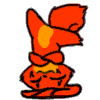
Chiptune - Battletoads GB Complete Soundtrack in FamiTracker
> CLICK HERE FOR FTM & NSF DOWNLOAD <
All 14 music tracks.
1) Main Theme
2) Dark Queen
3) Professor T. Bird
4) Enemy
5) General Slaughter
6) Need to Speed
7) Scuzz
8) Darkling
9) Wurm
10) Race
11) Big Blag
12) General Vermin
13) Firefight
14) Robo-Manus
I must have been completely insane to do a project of this magnitude just on a whim. It took me a few days in FamiTracker, but it's done. I made two versions: a plain edition in the default Ricoh 2A03 soundchip, and another version using the Konami VRC6 expansion chip so I could use its sawtooth channel for the bass.
I must say that I don't know if I'll ever attempt to convert an entire soundtrack all at once like this again. XD But I felt inspired - this was always one of my favorite 8-bit soundtracks, and Battletoads for Game Boy is not as well-known as the completely different NES game. Now I can say that I did it, and that it turned out good.
Now, for some more technical commentary.
The .ftm files I have provided for download intentionally have as much redundant data as possible. Lots of duplicate patterns. And though there are lots of instruments, many of them ended up going unused, and there are no unique instruments customized for individual songs (for volume, etc.). My intent is that it can still be extensively edited and modified as needed in FamiTracker.
The 2A03 version uses no expansion chips, but it's also missing something the Game Boy sound system has - volume control for the triangle wave, typically used for bass in chiptunes. So the 2A03 version's triangle wave bass is always at the same loudness, which loses some of the dynamic effect a louder or quieter bass accomplished in the original Game Boy version. This is why I also made a separate VRC6 version where I transferred the bass to the VRC6 sawtooth channel. The 2A03 triangle wave sounds smoother than Game Boy triangle wave, and the VRC6 sawtooth sounds coarser than the Game Boy triangle wave - take your pick.
As for adapting the music itself, I did it all by ear. But I'm not crazy enough not to listen to individual Game Boy channels in isolation, so I did that to separate as much detail as I could. David Wise has always been a fairly competent 8-bit composer, making a lot out of relatively little to work with. In this soundtrack he made heavily use of standard instrument fades - aside from the bass, you almost never hear an instrument play a note unless it's being faded from the onset. And though he's been known to use vibrato in his NES soundtracks, this one used very little of it - I only used it the "General Vermin" track, and even then it was super-subtle. One thing David Wise always used with great abundance in 8-bit music, are melody echoes. If he could, he'd dedicate a second channel to play a quieter delayed echo of a main melody. And sometimes, if he couldn't spare another channel, he staggered lead and echo in the same channel by putting the melody only in every even slice of time and putting the echo only in every odd slice of time, producing that "choppy echo" sound he's really known for. (I ended up borrowing the same technique for 2A03 arrangements of his Battlemaniacs songs.) And another quirk that is ubiquitous in this particular soundtrack, is how, if the melody is played as a series of chords, the (usually) upper tones of the chord are played with a very slight delay, often just 1/60 or 2/60 of a second. When I did my first Battletoads chiptunes, this was utterly annoying, because it meant having to micromanage exact timing of entire melody segments using Gxx effects; but now I can see the real difference it makes, providing a certain added character to the music.
Remember the rule of thumb when playing Battletoads games: If at first you don't succeed, try and try again hundreds of times until you get it right, and let David Wise's music be your sassy salve.
(The image uploaded is not the actual submission. It is meant to provide a thumbnail. Also, it was fun to edit.)
All 14 music tracks.
1) Main Theme
2) Dark Queen
3) Professor T. Bird
4) Enemy
5) General Slaughter
6) Need to Speed
7) Scuzz
8) Darkling
9) Wurm
10) Race
11) Big Blag
12) General Vermin
13) Firefight
14) Robo-Manus
I must have been completely insane to do a project of this magnitude just on a whim. It took me a few days in FamiTracker, but it's done. I made two versions: a plain edition in the default Ricoh 2A03 soundchip, and another version using the Konami VRC6 expansion chip so I could use its sawtooth channel for the bass.
I must say that I don't know if I'll ever attempt to convert an entire soundtrack all at once like this again. XD But I felt inspired - this was always one of my favorite 8-bit soundtracks, and Battletoads for Game Boy is not as well-known as the completely different NES game. Now I can say that I did it, and that it turned out good.
Now, for some more technical commentary.
The .ftm files I have provided for download intentionally have as much redundant data as possible. Lots of duplicate patterns. And though there are lots of instruments, many of them ended up going unused, and there are no unique instruments customized for individual songs (for volume, etc.). My intent is that it can still be extensively edited and modified as needed in FamiTracker.
The 2A03 version uses no expansion chips, but it's also missing something the Game Boy sound system has - volume control for the triangle wave, typically used for bass in chiptunes. So the 2A03 version's triangle wave bass is always at the same loudness, which loses some of the dynamic effect a louder or quieter bass accomplished in the original Game Boy version. This is why I also made a separate VRC6 version where I transferred the bass to the VRC6 sawtooth channel. The 2A03 triangle wave sounds smoother than Game Boy triangle wave, and the VRC6 sawtooth sounds coarser than the Game Boy triangle wave - take your pick.
As for adapting the music itself, I did it all by ear. But I'm not crazy enough not to listen to individual Game Boy channels in isolation, so I did that to separate as much detail as I could. David Wise has always been a fairly competent 8-bit composer, making a lot out of relatively little to work with. In this soundtrack he made heavily use of standard instrument fades - aside from the bass, you almost never hear an instrument play a note unless it's being faded from the onset. And though he's been known to use vibrato in his NES soundtracks, this one used very little of it - I only used it the "General Vermin" track, and even then it was super-subtle. One thing David Wise always used with great abundance in 8-bit music, are melody echoes. If he could, he'd dedicate a second channel to play a quieter delayed echo of a main melody. And sometimes, if he couldn't spare another channel, he staggered lead and echo in the same channel by putting the melody only in every even slice of time and putting the echo only in every odd slice of time, producing that "choppy echo" sound he's really known for. (I ended up borrowing the same technique for 2A03 arrangements of his Battlemaniacs songs.) And another quirk that is ubiquitous in this particular soundtrack, is how, if the melody is played as a series of chords, the (usually) upper tones of the chord are played with a very slight delay, often just 1/60 or 2/60 of a second. When I did my first Battletoads chiptunes, this was utterly annoying, because it meant having to micromanage exact timing of entire melody segments using Gxx effects; but now I can see the real difference it makes, providing a certain added character to the music.
Remember the rule of thumb when playing Battletoads games: If at first you don't succeed, try and try again hundreds of times until you get it right, and let David Wise's music be your sassy salve.
(The image uploaded is not the actual submission. It is meant to provide a thumbnail. Also, it was fun to edit.)
Category Music / Game Music
Species Unspecified / Any
Size 640 x 576px
File Size 3.6 kB
Yeah. Completely different game too. https://www.youtube.com/watch?v=kGqzaNrz2ZE

 FA+
FA+
![Chip - Final Fantasy VI - The Wild West [The Veldt] (VRC6)](http://t.furaffinity.net/18884463@200-1488278723.jpg)







Comments